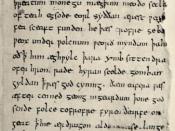Charles MartinÃÂs poem, ÃÂE.S.L.ÃÂ, is the mental reflection of an English teacher, who is teaching foreign students the English language in an E.S.L. (English as a Second Language) class. When reading ÃÂE.S.L.ÃÂ for the first time, one may easily become lost in finding the meaning of the poem. This is possibly due to the fact that the poem is teeming with the use of many common poetic elements, uncommon words with dual meanings, as well as elements that are unique to Martin. It is possible that the teacher Martin creates sees the dilemma of students aspiring to a fabricated dream. After many re-reads, the poem starts to break down into various ideas that support a main idea, which is freedom. After the final read of the poem, two profound conclusions are encountered: the first is the conclusion that language is the basis of oneÃÂs freedom, and the second is that any attempt at regulating the use of language is an infringement of that freedom.
Now we shall commence upon an in-depth explication so as to see the ways in which Charles Martin almost subliminally conveys his ideas to the reader.
Due to the excessive numbers of stanzas, it is apparent that the best method of analysis of the poem is by the examination of individual lines or stanzas. If we were to analyze the poem by going through the list of poetic elements, we would simply become overwhelmed, and the analysis would be incoherent and unorganized. However, it would still be advantageous to analyze the elements that are universal to the poem.
One of these elements is the form of the ten stanzas. While the form slightly varies, strong similarities are apparent. The first two lines of every stanza have six syllables. Only the first line of the...


